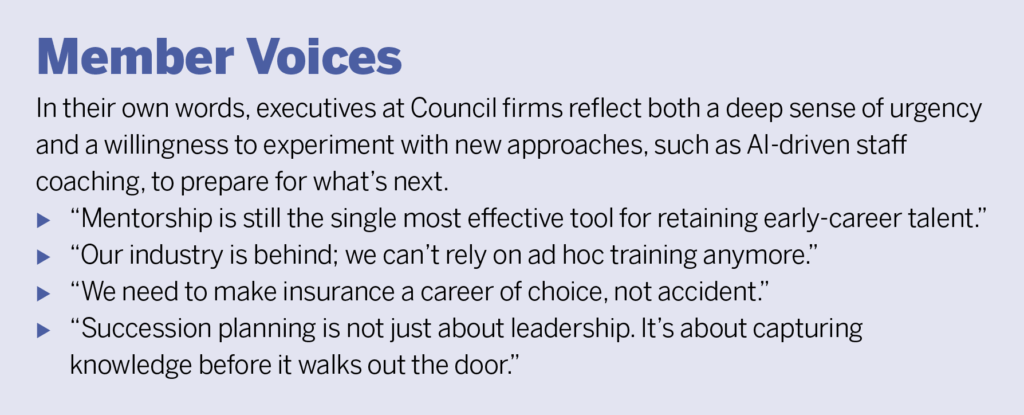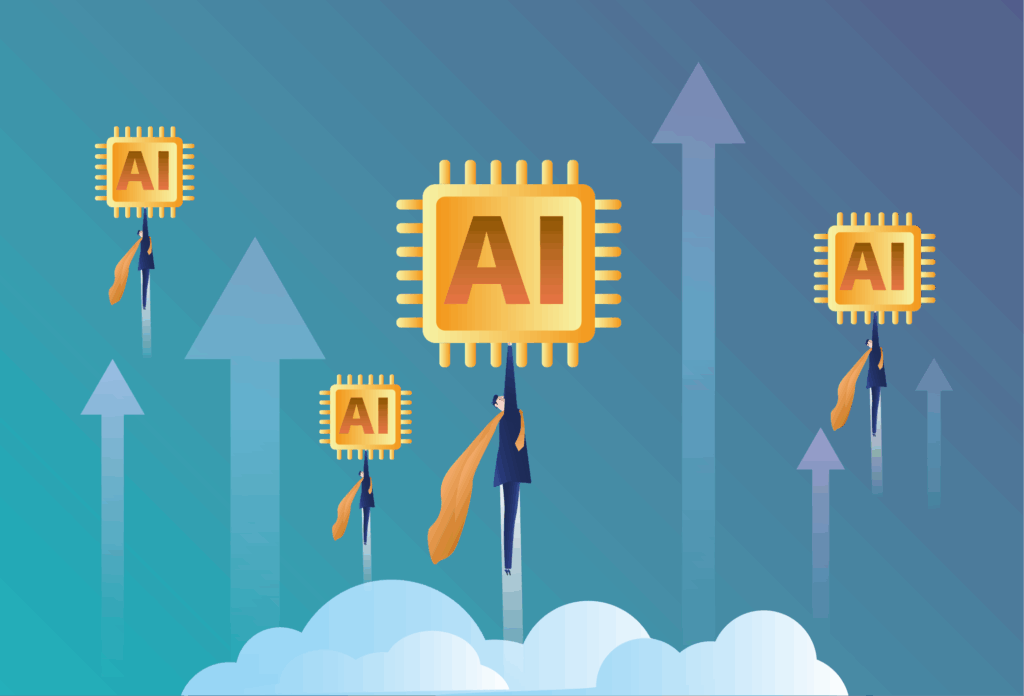
Talent Development Is Strategy

Across The Council’s membership, one theme has come through loud and clear in 2025: talent is a top business risk.
From succession planning to employee adoption of artificial intelligence (AI), leaders from our community have left no doubt that how firms develop their people will determine their ability to compete and grow.
The Council this year conducted a comprehensive program of interviews and surveys encompassing 149 voices from 71 Council member firms. The result is a unique, detailed snapshot of the industry’s talent development landscape.
The data, combined with candid insights from industry executives, paints a striking picture: firms that treat workforce development as a strategic investment are seeing measurable returns. Those that don’t risk being left behind.
The ROI of Investing in People
The returns on learning and development (L&D) programs are famously difficult to quantify, but some brokerages are making tangible correlations to their balance sheet. One firm reported that 43% of new business in the past two years came from employees who completed its internal sales development program, a direct correlation between training and revenue growth.
Another firm redesigned its producer onboarding around structured mentorship, pairing new hires with experienced leaders and incentivizing mentors with shared commissions. The result was employee retention rates well above industry norms.
Even firms with lean L&D teams found that modest investments, such as plug-and-play training to upskill service roles, have boosted engagement, allowed leaders to focus on higher-level coaching, and freed brokers for value innovation.
AI Meets Training
For executives, it’s not a question of whether AI will reshape their talent management strategies, but how fast.
Administrative tasks like policy checking and proposal development are being automated, pushing new hires into client-facing advisory work far earlier in their careers.
Several firms are piloting AI for real-time coaching, onboarding, and knowledge capture. For example, using voice-enabled tools that guide account managers through client calls in real time, or AI-driven playbooks that capture expert workflows and turn them into training modules.
Across the board, leaders emphasized the need for strong client advisory skills, data literacy, and the ability to translate insights into client value. To address these gaps, firms are investing in role-based training, embedding data tools into daily workflows, and coaching teams on how to frame technical expertise as strategic advice. As one executive put it, “Technology will change workflows, but human advisory skills are what clients will always pay for.” This shift is also redefining expectations for client-facing teams, moving from product-focused sales to needs-based consulting on risk and long-term planning.
Interestingly, size doesn’t insulate a firm from the challenges that accompany AI. Small firms see the technology as a potential equalizer, helping lean teams scale operations like onboarding, policy checking, and client reporting. Large firms are sometimes burdened by scale, wrestling with AI adoption across thousands of employees. Midsize firms are caught in the middle, eager to experiment but facing cultural resistance from tenured staff.
Learning and Development by Firm Size
Our work identified three clear (if very general) stages of maturity in talent development, based on a firm’s annual revenue:
- Firms that generate under $100 million per year lean heavily on mentorship and ad-hoc onboarding. Strengths include motivation and agility, but pain points include inconsistent upskilling, lack of dedicated L&D staff, and a pressing need for off-the-shelf training.
- Firms between $100 million and $999 million are actively building internal academies, experimenting with hybrid delivery for training, and piloting AI. They are investing in sales, onboarding, and leadership programs but face gaps in soft skills such as critical thinking and problem-solving.
- Firms at $1 billion and above operate more sophisticated internal universities aligned to business strategy. They leverage multimodality training delivery, data-driven employee pipelines, and robust leadership succession planning. Yet they report challenges in scaling training across geographies and capturing institutional knowledge before experts retire; regionalized approaches have been found to help address these obstacles.
Universal Challenges, Shared Priorities
Despite differences in size and maturity, firms consistently ranked the same top challenges, in this order:
- Limited internal training resources
- Time constraints
- Gaps in technical/specialized knowledge
- Budget constraints
- Lack of career growth opportunities
Priorities are similarly shared widely across the industry. Early career development remains the highest priority for most firms. Yet as agencies grow, many struggle to source enough experienced mentors to sustain structured onboarding and development programs. Some are trying to address this gap with technology that can scale training and capture institutional knowledge.
Front-line leadership and manager development is a universal need. Firms recognize that strong management is essential to staff retention and workplace culture, but few have structured programs to build this capability.
Technical expertise is at risk and the bar is rising. As one executive told us, “Our biggest risk isn’t losing clients, it’s losing knowledge when our experts retire.”
Soft skills and advisory capabilities are becoming just as critical as technical training. As routine work is automated, relationship-building and consultative advice are increasingly crucial differentiators to client value.
Consulting and leadership were ranked as the Nos. 1 and 2 most critical skills for success in the next three to five years, respectively, with 82% of survey respondents stating they were “somewhat prepared” by having staff competent in those areas.

Key Takeaways
What does all this mean for leaders making strategic decisions today?
Talent development isn’t a side project. Firms that view it as optional are already losing ground, while those that treat it as a growth lever are already seeing ROI.
AI and digital workflows are redefining brokerage operations. The winners will be firms that prepare people not just to use tools but to combine them with industry expertise and personal relationships.
Succession is urgent. With retirements accelerating, the window to capture institutional expertise is closing. Firms must prioritize knowledge transfer alongside leadership development.
Flexibility is key. Employees want modular, role-based, and tech-driven learning that fits into daily workflows. Firms should plan to build or buy with this in mind.
The industry is at a crossroads. Automation and AI are reshaping workflows, demographics are accelerating retirements, and client needs are becoming more complex. In this environment, talent development is no longer optional. It is a differentiator, a retention strategy, and an accelerator for growth. Yesterday was about technical knowledge and compliance. Today is about advisory skills and early career development. Tomorrow is about AI fluency, consultative leadership, and data storytelling.
The executives we spoke to were unanimous: firms that fail to invest now in talent development will not catch up later.




